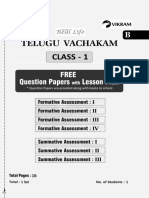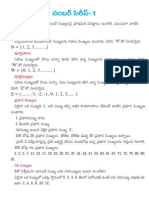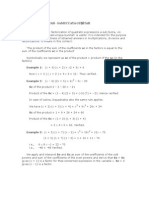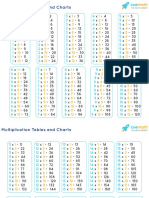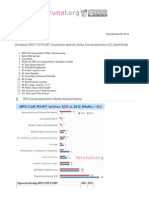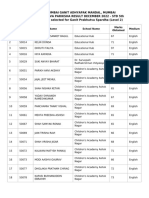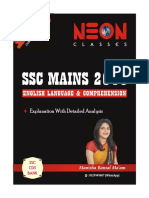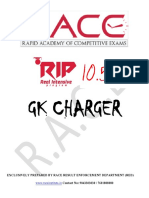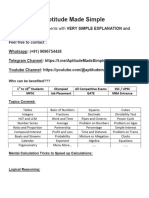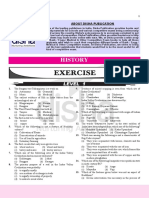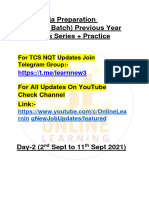0 ratings0% found this document useful (0 votes)
272 views202 pagesLearn C in Three Days
Learn c program in three days, by daily practices
Uploaded by
HARISH S ECECopyright
© © All Rights Reserved
We take content rights seriously. If you suspect this is your content, claim it here.
Available Formats
Download as PDF or read online on Scribd
0 ratings0% found this document useful (0 votes)
272 views202 pagesLearn C in Three Days
Learn c program in three days, by daily practices
Uploaded by
HARISH S ECECopyright
© © All Rights Reserved
We take content rights seriously. If you suspect this is your content, claim it here.
Available Formats
Download as PDF or read online on Scribd
You are on page 1/ 202
eA A GaGa UC
A
MLL ES
By n nr
Learn C
in Three Days
Sam A. Abolrous
BPB PUBLICATIONS
B-14, CONNAUGHT PLACE, NEW DELHI-110001
FIRST INDIAN EDITION-1993
Distributors:
BPB BOOK CENTRE
376, Old Lajpat Rai Market, Delhi-110006
BUSINESS PROMOTION BUREAU
8/1, Ritchie Street, Mount Road, Madras-600002
BUSINESS PROMOTION BUREAU
4-3-268-C, Giriraj Lane, Bank Street, Hyderabad-500195
COMPUTER BOOK CENTRE
12, Shrungar Complex, M. G. Road, Bangalore-5600014
COMPUTER BOOK CENTRE
Kothi No.—535, Sector-7, Panchkula-134109, CHANDIGARH
Copyright © Wordware Publishing, Inc., USA
The examples and programs contained in this book are compatible with the ANSI
standard, Microsoft C, Quick C, Turbo C++, Power C and many others. The
programs in this book were compiled using Turbo C++ and tested for compatibility
on Quick C and Power C.
Microsoft C and Quick C are trademarks of Microsoft Corporatios.
Turbo C and Turbo C++ are trademarks of Borland Intemational.
Power C is a trademark of Mix Software, Inc.
Other product names mentioned are used for identification purposes
only and may be trademarks of their respective companies.
Printed in India under arrangement with
WORDWARE PUBLISHING INC., USA
No part of ihis book may be repioduced in any form or by any means
without permission in writing from Wordware Publishing, Inc.
ISBN 81-7029-170-4
Published hy Manish Jain for BPB Publications, B-14, Connaught Place,
New Delhi and Printed by XPRESS GRAFICS, Dalhi-28
Chapter One — Your First Tour of C
1-1
1-2
1-3
1-4
1-5
1-6
1-7
Summary
Chapter Two — Input and Output.
2-1
2-2
2-3
2-4
Contents
DAY ONE
The C Program
Displaying Text . .
Crunching Numbers ae
Using Variables .......
Declaring Variables . .
Assignment
Drill1-1........
Multiple Assignment .
Formatted Output
Drill1-2........-
The Single Character Variable ... .
Text Strings and Pointers .......
Declaring Pointers .......
Initialization of Character Pointers .
Examining Memory Locations .
Drill 1-3 2. ee ee
Formatted Input... .........
Multiple Variables Per Statement
Mixed Types of Variables . . . .
Input Separators
The User Prompt . . .
Drill2-1 0 ee eee
A Closer Look at Text Strings .............2-
Declaration of a Character Array
Unformatted String Input
The Function gets . .
The Function fgets .
Drill2-2.......
Unformatted String Output
The Function puts. .
The Function fputs .................
2-5 CharacterInput ...............0.004
The Function getchar....... .
The Functions getch, and getche . oe
Drill 2-3 eee
2-6 Character Output ..............2.-2.
The Function putchar
The Function pute
Summary «1... 0... eee ee ee
Chapter Three — Putting Things Together... .... .
3-1 Literals 2.2... 2. ee ee ee eee
Drill3-1....
3-2 Basic Data Types . .
3-3. Type Conversion
The Range Problem. . .
The Type Casts ... .
Drill3-2........
3-4 The Precision of Results . .
3-5 Data Type Modifiers ....
3-6 Output Format........
Format Modifiers . . .
Drill3-3........
The Backslash Codes .
3-7 Input Format ............ 0.0 -0000-
3-8 Constants 2.2... ee ee ee ee
Summary 6 6. ee
DAY TWO
Chapter Four — All About C Operators .........
4-1 Expressions and Operators ............--
4-2 Arithmetic Operators .........
Modulo Division Operator
Increment and Decrement Operators . . .
Drill 4-10... . 66 eee eee
Precedence of Arithmetic Operators . . .
4-3 Relational and Logical Operators. ..........
Evalyation of Logical Expressions ...... .
Precedence of Relational and Logical Operators . . .
4-4 Assignment Operators ©... . 0.0.0.0 eee
4-5 Pointer Operators... 2-1... ee eee eee
Drill 4-2 2. ee ee ee
4-6 Special Operators . . oe os
The ? Operator .....
The Comma Operator . .
The sizeof Operator . . .
4-7 Bitwise Operators... ......005 eae tee
The Right Shift Operator oe we
The Left Shift Operator... ..........00.%
Precedence of Bitwise Operators. ..........
4-8 Precedence fo C Operators oe
Summary 2... ee eee
Chapter Five— Decisions ..............-2005-
5-1 Making Decisions
5-2 The Simple if Statement
5-3. The Complete if-else Structure
Drill5-1.........
5-4 Nesting Conditions .
5-5 The if-else-if Ladder
Drill 5-2... .
5-6 The goto Statement ......
5-7 Tipson UserInput ......
Pitfalls of Character Input
Numeric Input as a String
5-8 The switch Construct
Drill 5-3... . : oe oe see
Summary... ee eee -
Chapter Six— Loops... 1.2... 0.0002 cece eee
6-1 Looping... 2.2... ee eee
6-2 TheforLoop ........... 00.000 eeeeeee
The Loop Block
Infinite Loops .
6-3 The while Loop . .
The Factorial of aNumber . . .
Drill6-1..........00.8
The Power Operator. .
6-4 The do-while Loop .
Drill 6-2...
6-5 Nesting of Loops . . . oan wee
Drill 6-3 6. ee ee
6-6 Thebreak...............-, rs 90
6-7 Loopsand Arrays... 6. ee ee 91
Summary 6... ee ee 96
Chapter Seven — Functions and Macros.
7-1 The C Program Structure... .....
Prototyping of Functions .
The return of a Function .
The Function Definition
Example: A User Menu Function
Example: The Factorial Function
Drill 7-12.02... 0000005
7-2 Passing Variables to Functions oan
The Scope of a Variable... . . .
Example: The “Swap” Function .
Drill 7-22... 00.0.0 20008
7-3. Function Recursion
7-4 The Duration of a Variable ..........-.%
7-5 Storage Classes ........
Register Variables .
External Variables .
7-6 Macros .......
Drill 7-3... .
7-1 Header Files......
7-8 The “Project” Files
Example: The Secret-Letter Game
Summary «6. ee
DAY THREE
Chapter Eight — Data Structures
8-1 DataArchitecture......
8-2. AFinal Tour of Arrays .. .
Initialization of Arrays
Arrays and Pointers . .
Memory Allocation . . os see cae
Pointer Arrays 2... 0 ee ee
Passing ArraystoFunctions .........-.-.4% 123
Drill8-1.......... fee eee eee 125
vi
8-3 Structures ©... eee 125
Structure Templates and Variables 126
Accessing Members 127
Example: Employee Record . . 128
Structure Initialization - 130
Pointers to Structures 131
Structure Arrays and Databases . 133
8-4 Enumerations ....... 0.00.00. 0 eee eee
8-5 Defining Your Own Types. «
Summary 2... ee ee
Chapter Nine — Miscellaneous Tools .............. 139
9-1 Tools to Manipulate Strings... .. . . 139
The Length of a String strien . . oe -.. 139
String Conoatenation streat.............. 140
Copying Strings and Substrings strepy, strncpy . . . 142
Comparing Two Strings stremp ........... 143
Changing the Case strupr, strliwr .......... 144
String Segmentation strehr.............. 144
Changing the Case of a Character tolower, foupper . 145
Drill 9-1. oe . 146
9-2 Conversion Functions atol- Htoa . 146
9-3 Character Testing Tools isascii- -isxdigit wee 148
Drill 9-2 2. ee eee . 151
9-4 Executing DOS Commands system wee. 151
Summary 2... ee ee 152
Chapter Ten — Files and Applications ............. 153
10-1 DataFilesinC ............ » 153
Sequential and Random Access . . 153
Data Input Output . . 153
Access Functions . . :.. ++. 154
Files, Streams, and Physical Devices... ....46. 154
10-2 The File Protocol fopen, fclose
10-3. ASCII and Binary Files... .....
10-4 File Input and Output sae
Writing a Character toa Filepute ..........
Writing a String to a File fputs, fprintf
Reading Characters from a File gete . . tte
Reading a String fom a File fgets ..........
vii
10-5 Application 1: A Telephone Directory ........... 162
Drill 10-1 2... ee eee ee eee 166
10-6 Sending the Output to the Printer. . . . ae .. 166
Drill 10-2... 2... ee eee . 167
10-7 Filing Numbers as Strings sprintf . . . - 167
10-8 Application 2: Payroll . oe - - 168
Summary 2... ee ee ee ee 171
Appendix A The ASCII CharacterSet .............. 175
Appendix B The Prototypes of Functions
Discussed in This Book
Index ww we ee eee oe
viii
Preface
“Is it possible to Learn C in three days?” The answer is YES.
Without too much hassle with types of identifiers, pointers, and
constants, this book will take you to the heart of the C programming
language through step-by-step examples, giving you experience in C
in a small amount of time.
You start with simple programs which crunch some numbers and print
some strings, and you end up with useful applications of data
structures and files. The examples contained in this book are carefully
chosen to show you the pitfalls that you may face in creating your own
programs.
The second question is: “Which C am I going to lear ,?”
You know that there are many dialects of C around, such as Turbo C,
Quick C, Power C, and the extensions of C++, and so forth. The
original C language was introduced by Brian Kernighan and Dennis
Ritchie (K&R) in their book The C Programming. Language
(Prentice-Hall, 1978), then the proposed ANSI standard introduced an
expanded version of the language. The different versions of the
languages are nonportable in some areas (such as graphics), but you
can still write a portable program that compiles and runs using any
compiler. This is the main feature of this book. Whatever compiler you
use, the programs will still compile and run.
Sam A. Abolrous
DAY ONE
Chapter One
YOUR FIRST TOUR OF C
1-1 THE C PROGRAM
In order to see what the structure of a C program looks like, it is best
to start with a simple program. Figure 1-1 shows a program that
displays on the screen the message “Hi there.”
J+ Figure 1-1 ¢/
#include
main()
printf ("Bi there");
,
The heart of this program is the function printf, which actually does
the work here. As a matter of fact, the C language is built from
functions (like printf) that execute different tasks. The function(s),
however, must be used inside a framework which starts with the word
main(), followed by the block containing the function(s) which is
marked by the braces ({ }).
The first line starting with the characters /* and ending with the
characters */ is a comment. You may type as many lines as you wish
between these two sets of characters and the compiler will ignore them
as being comments. Comments can appear anywhere in the program.
The second line that starts with #include is called a directive. It is not
a part of the actual program. It is used as a command to the compiler
to direct the translation of the program. There are other directives
which must be used according to the type of functions used in the main
block, but this specific directive appears in all programs as it refers to
the standard input output header file (stdio.h). Many compilers may
compile this simple program successfully without the directive, but it
is a good habit to include this directive at the beginning of any C
Chapter One
program. When using more than one directive each must appear on a
single line. -
Blank lines and spaces inside the program are optional except the
blank space following the directives and similar keywords.
The function printf is embedded into a statement whose ending is
marked by the semicolon (;). This is important syntax of the C program
because the semicolon tells the compiler that a statement Is finished.
As is clear from Figure 1-1, all C programs are written in lowercase
letters.
1-2 DISPLAYING TEXT
The printf is the most important function used to display text on the
screen. Like any function it has two parentheses, between which
comes the string to be displayed, enclosed in quotations. Look at the
output of the program shown in Figure 1-2. It uses two successive
statements using the printf function.
NOTE .
A companion diskette comes along with this book to help
you save time and effort. This diskette contains the source
code of all the examples, in addition to the solutions to the
drills. You can either compile them directly or use them for
comparison and error checking. Please read the “readme”
file on the distribution disk. Just type the command
README and press Enter.
}* Figure 1-2 */
include
main()
printf("#i there");
printf (*Bov are you today?");
) :
If you compile this program and run it, the displayed output is:
AL thereBov are you today?
Just like that.
In order to have the output displayed on two separate lines you must
add the new-line character (\n) at the end of the first string, as shcwn
in Figure 1-3.
Your First Tour of C
/* Figure 1-3 */
#include
aain()
{
printf ("Bi there\n");
printf ("How are you today?*);
}
Now the output is:
EL there
How are you today?
It is clear that the new-line character (\n) comes right after the string
and must be inside the quotation marks. Each \n corresponds to a new
line, so you can skip another line by using \n\n at the end of the first
string.
Actually, any spaces or characters written between the quotations,
unless they have a special meaning, will be displayed as a past of the
text. Figure 1-4 demonstrates how to join two strings with | a blank
space between them.
dt Figure 1-4 #/
finclude
nain()
printf("Bi there, ");
printf("how are you today?");
}
The output of this program is:
Hi there, how are you today?
This way you can design a label for yourself, by writing a small
program like the one shown in Figure 1-5.
(+ Figure 1-5 ¢/
Finclude
main() 1
{
printf (*WORDWARE PUSLISBING, INC.’ SS w
printf("PLANO, TEXAS woniin")y
)
This program displays on the screen the following text:
WORDWARE PUBLISHING, 19. .
1506 CAPITAL AVEMUE
PLAWO, TEXAS 75074
More about the printf function later.
Chapter One
1-3 CRUNCHING NUMBERS
When dealing with numbers you have to pay attention to the type of
each number, whether float, integer, etc. Each type has to be used with
the printf function in a specific format. The example in Figure 1-6
displays the two numbers 128 and 128.0. The first is of the type int
while the second is of the type float. Notice two new characters inside
the quotation marks, %d (which stands for “decimal”), and. Jf (which
stands for “float”). The number itself appears outside the quotation
marks, preceded by a comma.
(+ Figure 1-6 ”
#include
aain()
‘ printf (*td\n", 128);
; printé(*#f\n", 128.0);
The characters %d and %f are called conversion specifiers. In this
program, they are used to tell the compiler about the types of numbers
appearing in the program, which in turn determine the suitable
memory storage locations. They are referred to also as format
characters or format specifiers. They have other properties that are
discussed later.
Executing this program displays the following:
128
128.000000
What if you used the wrong conversion specifiers? Try that by
swapping the %d and the %f as shown in Figure 1-7.
/* Figure 1-7 /
Finelude
aain()
printf(“8f\n",128);
printf ("td\n",128.0};
}
The output from this program is:
0.090000
0
Wrong results!
Some compilers, however, will give unpredictable results by dumping
some garbage numbers in the output.
Your First Tour of C
The printf can also handle mathematical expressions which are
evaluated and displayed. Figure 1-8 shows an example of such simple
mathematical expressions. The first one (128*2) is multiplication, and
the second (128.0/2) is division.
(+ Pigure 1-8 ¢/
#include
main()
‘ printf("td\n",12802);
printf ("sf\n",128.0/2);
}
The output from this program is:
256
64,000000
Did you notice that we used the integer 2 in the division? It is possible
to use mixed types and still get a float output, but it is recommended
to use the same type of numbers in the expression.
1-4 USING VARIABLES
Variables are actually memory locations, but programmers refer to
them by names because it is easier than referring to them by addresses.
In C, there are not as many restrictions on naming variables as with
other languages. Some names are reserved for the compiler (such as
int and main) because they have special meanings. The user-invented
names of the variables are called identifiers. They may be composed
of letters (a-z or A-Z), digits (0-9), or underscores (_), with the first
character being a letter or an underscore. A good feature of the C
identifiers is that they may be very long, which allows for descriptive
names like:
The_total_number_of_cars_sold_year_to_date
‘The_total_direct_cost_for_12_months_budget_period
If the identifier is longer than 32 characters, only the first 32 characters
are significant.
While both uppercase and lowercase letters are accepted as identifiers,
they are not equivalent. In other words, the variable “PRICE” is not
the same as the variable “price.”
Chapter One
DECLARING VARIABLES The most important restriction on
using variables is that they have to be declared at the beginning of the
program. For example:
/* Pigure 1-9 */
Finclude
nain()
{
/* Declarations */
int a;
float b;
/* Display output */
printf(*sd\n*,a);
printf(*#f\n",b);
}
As you can see in Figure 1-9, the declarations come at the beginning.
Two variables are declared, “a” as an integer, and “b” as a float. The
next part of the program displays the values stored in the variables
using the suitable conversion specifiers. No values are really stored in
the variables so far, so you should expect the output to be something
like:
7212
0.000000
The first value is nothing but what was there in the memory location.
In other words, variables which are not initialized or assigned values
may contain garbage.
ASSIGNMENT In the next step we assign values to these variables.
See Figure 1-10.
/* Hgure 1-10 */
#include
main()
{
/* Declarations */
int a;
float b;
/* Assignment */
a=1024;
be512;
/* Display output */
printé("td\n",a);
printe(*sf\n",b);
Now the program contains one more part, where the value 1024 is
assigned to the variable “a,” and the value 512 is assigned to the
variable “b.”
Your First Tour of C
This program gives the result:
1024
512.000000
You also can assign variables (or expressions containing variables) to
other variables as in the following example, Figure 1-11.
/* Figure 1-11 */
Hinclude
main()
{
/* Declarations */
int a;
float b,c; /* Notice multiple declaration */
/* Aspignnents */
a 1024;
b= a/2.0;
ce bray
/* Display output */
print£(*the result © ¢f\n",c);
}
The output of this program is:
The result = 1536.000000
Here the expression “a/2.0” is assigned to the variable “b,” then the
sum of “a” and “b” is assigned to the variable “c.” Finally, the result
stored in “c” is displayed preceded by a suitable text string.
You must have noticed in Figure 1-10 that an integer value (512) was
assigned to a float variable, and the result was a correct float number
(512.000000); however, the opposite will lead to truncation of the
fraction part, if any. The following example demonstrates this
truncation when dividing 8 by 3. See Figure 1-12.
J+ Figure 1-12 +/
#include
main()
{
/* Declarations */
be 0/3;
/* Display output */
printf("td\n",b);
The output is:
2
Chapter One
DRILL 1-1
The following three examples are different trials to display the value
of the fraction “3/4”; only the last one is correct. Try them all to see
the different responses of the compiler to errors. C compilers are
different in responses. Some of them may compile the program
without any error messages but result in an erroneous output.
J* Figure 1-13 #/
include
main()
printé("td\n",3/4);
)
/* Pigure 1-14 */
Hnclude
main()
printg("#f\n",3/4);
}
J+ Figure 1-15 #/
Hinclude
main()
printt(*st\n",3.0/4.0);
MULTIPLE ASSIGNMENT Multiple assignment is possible in C.
You can, for instance, assign the value 24 to more than one variable x,
y, and z using one statement as follows:
xeyere 2;
Another shortcut is to declare a variable and assign it a value in one
statement like:
int price of_unit=99;
float radius=3.65;
This is called variable initialization.
The following example demonstrates these shortcuts, as well as
multiple display of all the variables using one printf function:
10.
Your First Tour of C
© Figure 1-16 */
#include
main()
{
int a,b,c;
float 303.4;
aeb=c=24;
printf(*a=td,\nb=8d,\nc=td, and\nx=tf\n",a,b,c,x);
}
The output of the program is:
and,
be24,
e=24, and
x=3.400000
TIP
It is well known that, when locating syntax errors, many C
compilers always “talk about something else!” Try to
remove a semicolon or a single comment character from a
program, and compile it. Only rarely does the error message
tell you about the missing character, but it may tell you
instead about everything else in the world. With such a
feature, you have to be careful when writing your
statements. This is much easier than trying to figure out
afterwards what the mistake was.
1-5 FORMATTED OUTPUT
The function printf is called “The print formatted output function,”
because it enables the programmer to format the output using either
strings that appear in the output, or format characters such as %d and
%f. You may wish to see the number 75.000000 displayed in a more
manageable form like 75 or 75.00. This is done by using modifiers
along with the format characters in order to specify the required field
width.
The format % .0f will suppress all the zeros to the right of the decimal
point, while the format %.2£ will keep two zeros only, and so forth.
Let us look at some examples in Figure 1-17.
© Figure 1-17 ¢/
#include
aain()
{
float x;
375;
printf (“s.0f\n",x);
Chapter One
printf ("t.1f\n",x);
printf (*\.2E\n",x);
)
The output is:
5
15.0
15.00
The value of “x” is displayed three times in three different formats: the
first one without any decimal places, the second with one decimal
place, and the third with two decimal places.
What if there is a number containing fractions? The number will be
rounded to the required number of decimal places, as stated in the
format. The following example shows different approximations of the
number “0.75”:
7+ Figure 1-18 */
#include
main()
printt("s.0f\n",3.0/4.0);
print¢("s.1f\n",3.0/4.0);
printf("s.2¢\n",3.0/4.0);
The output is:
1
0.8
0.75
DRILL 1-2
Write a program to assign the number 3.45678 to a variable named
“number,” then display two outputs:
1- The “number” rounded to the nearest integer value.
2- The “number” rounded to tvo decimal places.
Display each output on a separate line, preceded by the suitable text.
1-6 THE SINGLE CHARACTER VARIABLE
The third type of variable, in addition to int and float, is the char
variable that can only hold a single character. Any data character can
be stored in a char variable, including unprintable characters.
12
Your First Tour of C
Character variables are declared using the char keyword. For
example; to declare a variable “b” of the type char write the statement:
char b;
To assign a character to this variable, it must be enclosed in single
quotes:
ben;
It is now time to introduce the conversion specifier %c (which stands
for “character”), which is used with char type variables. In the
following example you declare the variable “first_letter,” assign it a
value “A,” then display its contents using the %c conversion specifier.
/* Pigure 1-19 */
#include
pain()
{
char firet_letter;
firat_letter=’A";
printf (*tc\n",first_letter);
,
The output is:
a
If you use the conversion specifier %d to display the contents of the
variable “first_letter” instead, you get the ASCII value of the character
instead of the character itself (see the ASCII codes in appendix A).
Now add one more line to the program as follows in Figure 1-20:
J+ Figure 1-20 */
#include
aain()
{
char first_letter;
tirat_letter=/A";
printf(*tc\n*,first_letter); /* display the character */
printt("sd\n",firet_letter); /* display the ASCII of the character */
}
The output is:
a
65
This program makes clear the meaning of the name “conversion
specifiers.” As you can see, they are used to convert the type of the
output data.
Without using any variables you can just write the statement:
print£("tc\n",65);
which gives the output “A.”
13
Chapter One
You can also write the statement:
printt("sd\o",‘a");
which gives the output “65.”
1-7 TEXT STRINGS AND POINTERS
Strings in C are handled differently than in any other language.
When a text string is stored in the memory, you keep track of the first
character by storing its address in a special type of variable called a
pointer.
Knowing the beginning address and the length of the string, the
program can locate it. This means that a pointer is a variable containing
an address of another variable (rather than data). Pointers play a very
important role in C, and they can point to any type of data.
DECLARING POINTERS The pointer is declared using the
indirection operator (*). For example, if a pointer “a” is pointing to an
integer, it is declared as:
int *a;
If “a” is a pointer to a character, it is declared as:
char *ay
INITIALIZATION OF CHARACTER POINTERS In the
following example, a character pointer “a” is used to point to the
location of the first character in the string “Hello again.” Then the
value of “a” is displayed using the new conversion specifier Ys
(which stands for “string”), which is of course used with strings.
+ Pigure 1-21 */
#include
aain()
{
char *a;
as"Hello
printf (*W
,
The output is:
Hello again.
In this example “a” is a pointer to a char, while “*a” is the data being
Pointed to, which is actually the first letter in the string (H).
14
Your First Tour of C
The example in Figure 1-22 demonstrates handling two strings using
pointers:
(* Pigure 1-22 #/
#include
main()
{
char ¢a,*b;
ae"Hi, I am the string pointed to by the pointer a.*;
be"Hello, 1 am the string pointed to by the pointer b. *;
printf("ts\nts\o",a,b);
}
The output is:
Bi, I am the string pointed to by the pointer a.
Bello, I am the string pointed to by the pointer b.
EXAMINING MEMORY LOCATIONS In order to make sure
that you understand the meaning of the pointer, examine the output of
the program in Figure 1-23. This program points to the string “Hello
again” with the pointer “a.” Then, using the proper conversion
specifier, you can examine the addresses and contents of variables. A
new conversion.specifier %p is introduced in the program, which is
used to convert the output to hexadecimal numbers.
J+ Pigure 1-23 */
#include
main()
{
print£(*ta\n'
print£(*tc\n'
print #(*sd\n'
print#(*\p\n",a);
printé("td\n",¢a);
The output of this program is:
Hello again
a
168
ong
n
The first printf statement displays the string itself by the use of the
conversion specifier %s. The second one displays the character
pointed to by the pointer, using the conversion specifier %c. The third
and the fourth printf statements display the address contained in the
pointer in decimal and hexadecimal respectively, using the conversion
specifiers %d and %p. The last printf statement displays the ASCII
of the first character in the string (72 is the ASCII of the letter H).
15
You might also like
- Maths Resource Material 2015 For TeachersNo ratings yetMaths Resource Material 2015 For Teachers174 pages
- ఆంధ్రప్రదేశ్ విభజన సమస్యలు 300 బిట్ బ్యాంకు స్మార్ట్ వ్యూ మ్యాగజైన్No ratings yetఆంధ్రప్రదేశ్ విభజన సమస్యలు 300 బిట్ బ్యాంకు స్మార్ట్ వ్యూ మ్యాగజైన్26 pages
- C Language Handwritten Notes With Sample CodesNo ratings yetC Language Handwritten Notes With Sample Codes103 pages
- Ebooks Join Our Telegram Channel:-Https://T.Me/PdfbasketNo ratings yetEbooks Join Our Telegram Channel:-Https://T.Me/Pdfbasket87 pages
- Important Shortcut Tips To Solve Numerical ProblemsNo ratings yetImportant Shortcut Tips To Solve Numerical Problems25 pages
- Day - 3 Practice Class For CGL Pre 2022 by Abhinay SharmaNo ratings yetDay - 3 Practice Class For CGL Pre 2022 by Abhinay Sharma36 pages
- Input Output 1 Logical Reasoning Handout CetkingNo ratings yetInput Output 1 Logical Reasoning Handout Cetking6 pages
- Grade - 10 Computer Engineering - Object Oriented Programming0% (1)Grade - 10 Computer Engineering - Object Oriented Programming114 pages
- Data Mining Model For Predicting Student EnrolmentNo ratings yetData Mining Model For Predicting Student Enrolment8 pages
- Ganit Prabhutva Pariksha Selected List STD 5th 20230112No ratings yetGanit Prabhutva Pariksha Selected List STD 5th 202301124 pages
- Ourmechanicalengg Wordpress Com Quantitative AptitudeNo ratings yetOurmechanicalengg Wordpress Com Quantitative Aptitude656 pages
- Utkal University Question Paper 5th Semester ChemistryNo ratings yetUtkal University Question Paper 5th Semester Chemistry12 pages
- Al Kelley, Ira Pohl - A Book On C - Programming in C (1997, Addison-Wesley Professional) - Libgen - LiNo ratings yetAl Kelley, Ira Pohl - A Book On C - Programming in C (1997, Addison-Wesley Professional) - Libgen - Li754 pages


